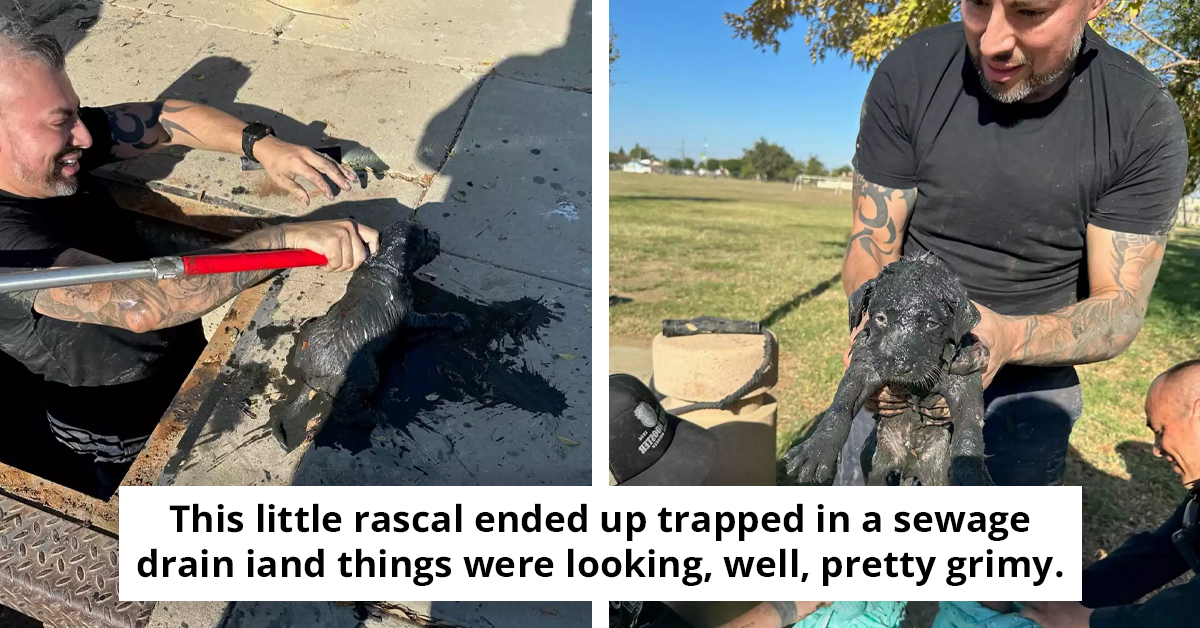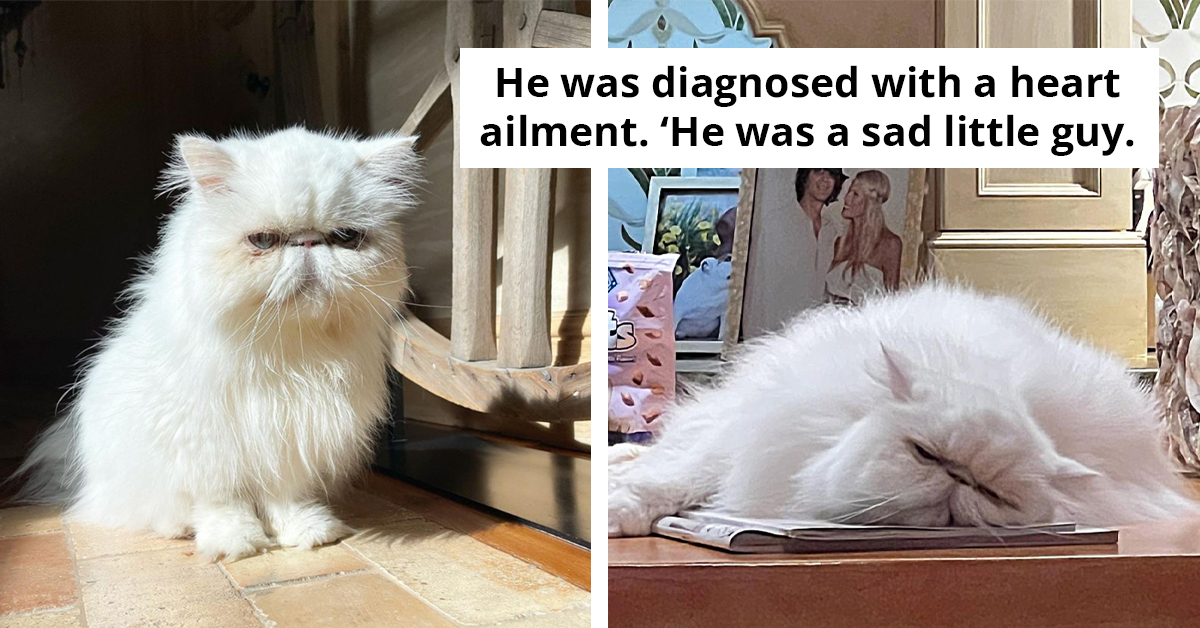Redditor's Dog Reacts to Harassment from Her Niece with Growling; Father Wants Dog to Be Put Down
Imagine having a big, friendly dog as a buddy and being part of a close-knit family. But what happens when the dog and a little kid clash?
This story teaches us about taking care of pets, communicating honestly, and making amends within the family. The OP in this story knows a lot about dogs.
She has looked after many dogs and helped them with issues such as not getting along with other animals, being too anxious when left alone, or chasing things excessively. She has seen it all.
Currently, she has a lab mix dog that resembles a big, cuddly teddy bear, and it loves everyone, especially kids. However, here's the thing: no matter how nice a dog is, it's never a good idea to leave it alone with small children.
Why? Because kids might not understand when the dog has had enough. The dog might show that it's unhappy in ways like growling, but kids might not realize it's a sign to back off.
OP's niece isn't good with the dog. She does things that annoy the dog, like pulling its tail, sitting on it, and shouting at it.
The dog is patient, but even the most patient dogs can reach their limit. OP tries to stop the niece's behavior, but it's tough. She has talked to the niece's dad multiple times, but he hasn't fully grasped the situation.
One day, something unfortunate happens. The dog finally loses its patience and growls at the niece. OP steps in, but it's too late; OP's brother gets angry and leaves, insisting that the dog should be put down.
OP knows she messed up by not stopping the bad behavior earlier. She feels sad and wants to make things right, but her brother won't talk. It's a difficult situation. She doesn't want to hurt her furry friend, but she also doesn't want to lose her family.
OP is experienced in handling various dog behavioral issues, but her philosophy is rooted in the belief that even the gentlest dog can be overwhelmed by children who might not comprehend their boundaries, leading to potential problems for both the dog and the kids.
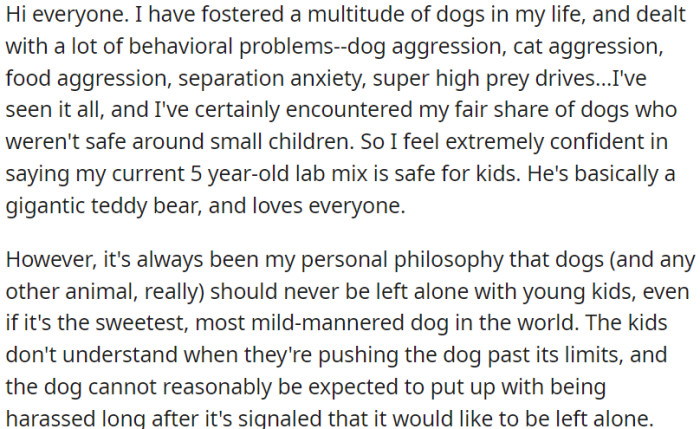
OP's niece mistreats her dog despite OP's attempts to stop her. OP's brother and sister-in-law don't grasp the seriousness.
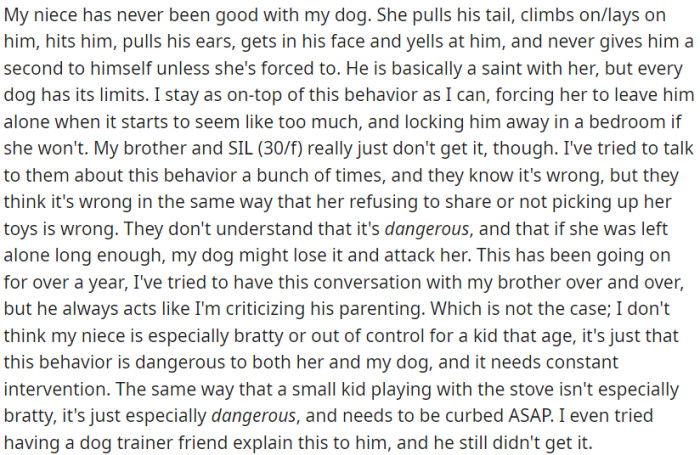
When OP's brother and niece visited, and while OP was cooking, she didn't monitor the dog around the niece, and it growled at her. OP took the dog away and didn't punish it. She wanted to discuss the situation with her brother, but he got angry, called for the dog to be put down, and left.
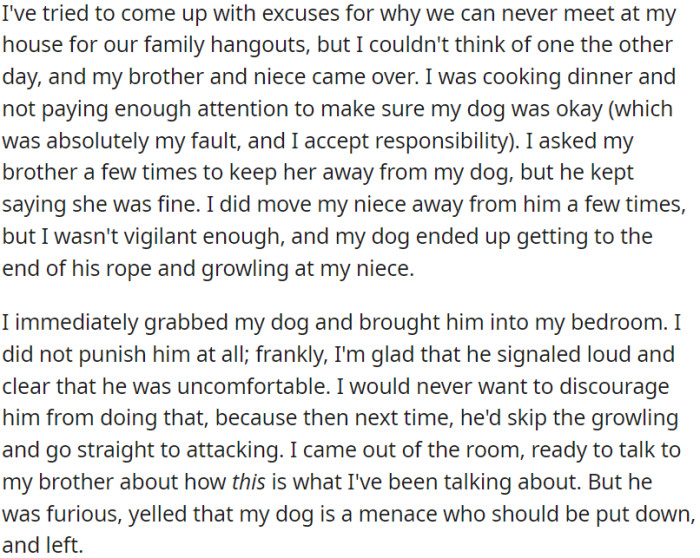
Understanding Canine Behavior and Family Dynamics
Dog behavior can be significantly influenced by their environment and the interactions they have with family members. Research published in the Journal of Veterinary Behavior indicates that dogs often mirror the emotional states of their handlers, making it crucial for family members to maintain a calm demeanor.
When children create chaotic environments, it can lead to stress for the dog, resulting in defensive behaviors such as growling.
Understanding Canine Behavior
The dog's growling in response to harassment reflects a natural animal behavior rooted in communication and stress response. Research in animal behavior indicates that growling is a form of warning, signaling discomfort or a need for space. According to studies published in the Journal of Veterinary Behavior, recognizing these signals is crucial for ensuring the safety of both pets and humans.
In this case, the dog's behavior highlights the importance of respecting animal boundaries and understanding their communication.
OP's brother remains upset and is solely focused on having the dog put down.
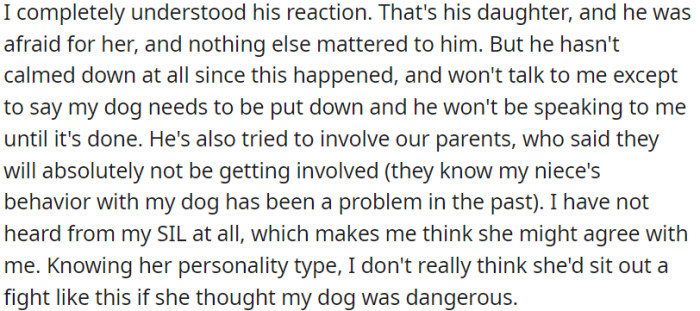
OP's dog endured harassment for a year before signaling that he had had enough in a harmless manner.
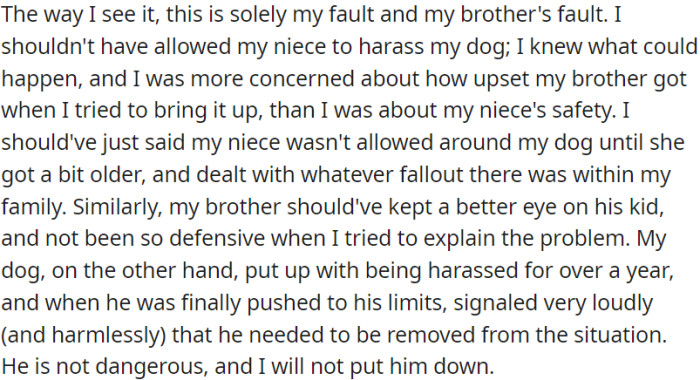
OP thinks that solutions like creating a dog-free zone or separate visits could help.
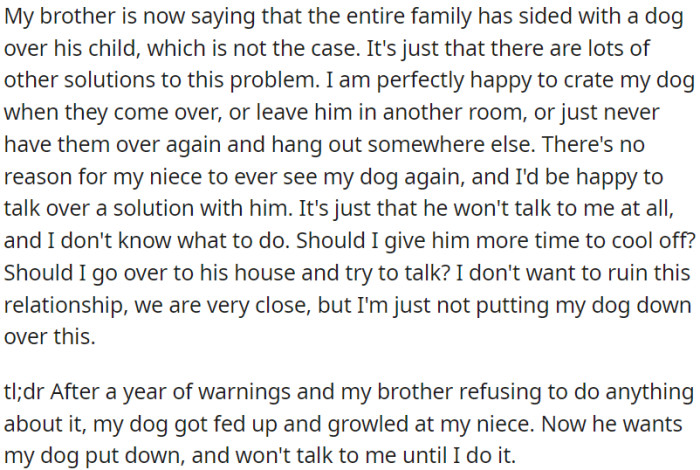
Conflicts surrounding dog behavior can evoke strong emotions within families, particularly when it comes to perceived threats. As Dr. John Gray, relationship author and expert, states, "Understanding the dynamics of family interactions is crucial, especially when pets are involved." Recognizing the signs of stress in dogs can help family members respond appropriately, fostering a safer environment for both the pet and the child. For more insights, visit Dr. John Gray's website.
From a psychological perspective, the father's desire to put the dog down raises significant ethical concerns regarding animal welfare and emotional attachment. Research indicates that emotional responses to pets can cloud judgment, leading to decisions that may not be in the best interest of the animal. This dynamic can create conflict within families, particularly when children's interactions with pets are involved.
The problem doesn't revolve around OP's brother's daughter or the dog; rather, it's about his inability to educate her about appropriate conduct.

OP's brother is a negligent father, ignoring the danger his child is in by allowing her to bother a pet despite multiple warnings.
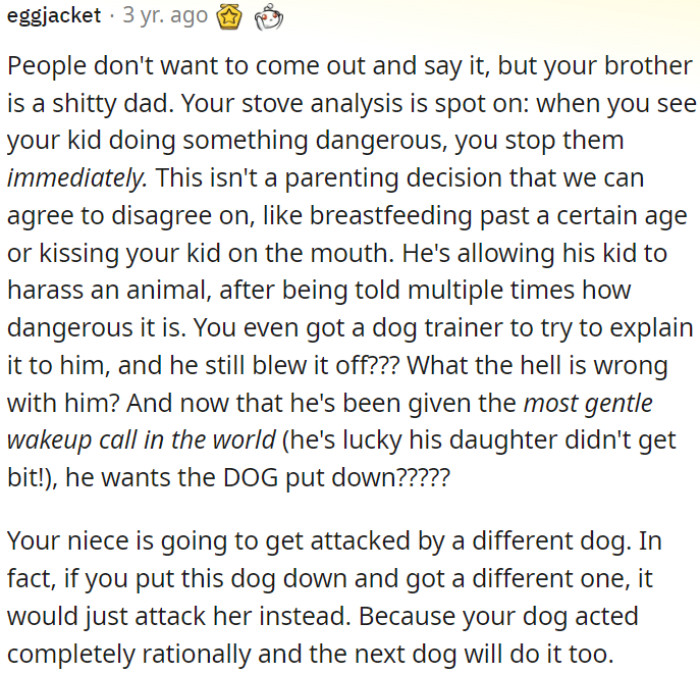
OP's brother should educate his child about respecting animals.
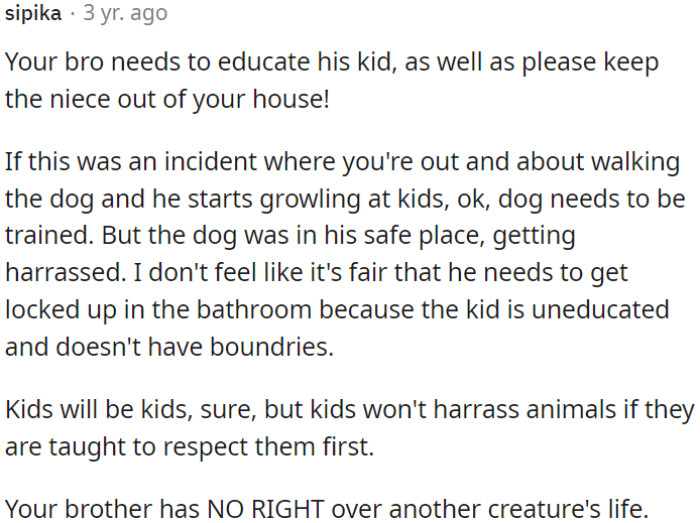
The Role of Emotional Regulation in Family Conflict
Emotional dysregulation can exacerbate conflicts, particularly in high-stress situations. Research suggests that when individuals are unable to manage their emotions, it can lead to heightened tensions and misunderstandings.
According to studies in clinical psychology, teaching emotional regulation skills can significantly reduce conflict and improve family dynamics.
The Role of Education in Animal Handling
Educating family members about proper animal handling and behavior can significantly reduce misunderstandings and conflicts. Studies show that increased knowledge about animal behavior can lead to more harmonious interactions and a greater appreciation for the pet's needs. Engaging in training programs for both the dog and the family can foster better relationships and enhance safety.
In this scenario, the family could benefit from learning about canine body language and communication, which could prevent future conflicts and misunderstandings.
OP should separate the dog and niece if needed.

Parents must teach kids how to handle dogs.

It's evident that OP's brother lacks common sense in handling animals.

Practical approaches to managing family conflicts around pets include establishing clear guidelines for interactions with animals. Educating children on proper behavior around pets can promote safer interactions and reduce anxiety for everyone involved.
Family therapy can also help address underlying emotional issues, improving overall family dynamics and fostering healthier relationships.
Moreover, open communication within the family regarding pet care and boundaries is essential. Research highlights that families who engage in discussions about pet behavior and care are better equipped to handle conflicts constructively. Encouraging a collaborative approach to pet ownership can enhance understanding and reduce conflict.
OP's brother's behavior is disrespectful.
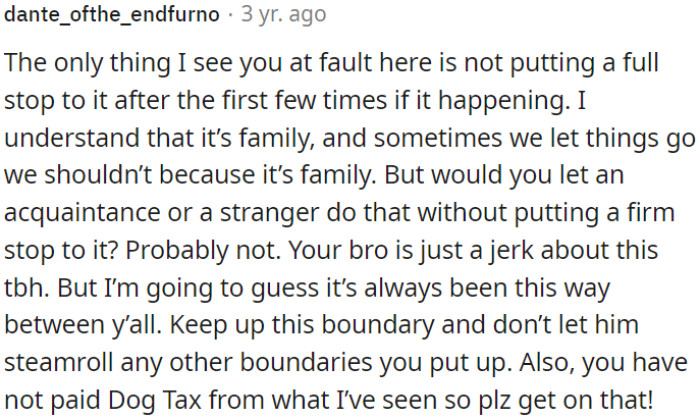
OP has to preserve the dog's life.

It's wise for OP to keep the dog away from his niece to avoid potential harm, despite personal feelings.

Promoting Safe Interactions with Pets
Creating a safe environment for both pets and children is essential in fostering healthy family dynamics. Research shows that clear communication about pet care and behavior can mitigate misunderstandings and conflicts.
Establishing rules for interactions with pets can help ensure that everyone feels safe and respected, enhancing the overall family atmosphere.
Navigating Family Dynamics Involving Pets
When family members disagree about pet care, it’s crucial to approach the situation with empathy and a willingness to listen. Research indicates that acknowledging each person's perspective can facilitate a more productive dialogue. For the father, it may be helpful to express concerns about the dog's behavior without resorting to ultimatums, fostering an environment where all family members feel heard and respected.
Engaging in family discussions about pet care can provide a platform for addressing concerns while reinforcing the importance of compassionate treatment of animals.
It's clear that OP should have been more careful to stop the behaviors that upset the dog in the first place. However, it's also important to remember that the parents of the little kid have a role to play in this too.
Pets are great companions, but they also need kindness and understanding, just like people do. Making the dog go away forever is not the right answer.
When the dog growled, it was communicating that it didn't like what was happening. This is actually a good thing – it means the dog is trying to express itself instead of resorting to aggression right away.
If we punish the dog for indicating its discomfort, it might learn not to communicate next time. This could lead to more dangerous situations later on.
Instead of blaming the dog, the family should focus on teaching and communicating. Kids need to learn how to be kind to pets, and they need to understand that animals can feel emotions too.
Additionally, the parents should recognize their role in this and try to find a way to keep the child safe and the pet happy.
Psychological Analysis
This situation reflects the complexities of family dynamics involving pets. The father's reaction to the dog's growling indicates a misunderstanding of animal behavior, which can lead to drastic decisions. Encouraging education about pet behavior and communication can help family members navigate these challenges more effectively.
Analysis generated by AI
Analysis & Alternative Approaches
Understanding canine behavior and fostering open communication about pet care is vital for maintaining harmony within families. Research from the Journal of Veterinary Behavior emphasizes the importance of education in reducing conflicts related to pets. By promoting empathy and understanding, families can create a supportive environment that values the well-being of both animals and humans.
Psychological Analysis
This situation underscores the complexities of navigating family dynamics involving pets. The father's response reflects a lack of understanding of canine behavior and the emotional needs of both the child and the dog.
Educating family members about appropriate interactions with pets is essential for fostering a harmonious environment.
Analysis generated by AI
Analysis & Alternative Approaches
Addressing family conflicts involving pets requires understanding, empathy, and open communication. By fostering safe interactions and promoting emotional regulation, families can navigate these challenges more effectively.
Ultimately, creating a supportive environment for both pets and children can enhance family dynamics and ensure that everyone feels valued.


